Designing a Warehouse Conveyor System That Adapts to Changing Inventory Needs

Inventory is unchanged: Product types shift, order volumes spike, and storage zones change. A rigid setup can slow everything down. That’s why a flexible warehouse conveyor system is so important. It keeps operations moving, even when the warehouse layout, stock types, or seasonal demand changes.
A system that works today may struggle six months from now. The right design helps your warehouse keep up without needing a full rebuild.
Start With How Inventory Moves, Not Just Where It Sits
Before choosing equipment, walk through your actual product flow.
Ask simple questions:
- How are products received and stored?
- Where are they picked and packed?
- How often do these zones change?
- Are certain items picked more often than others?
- Do product dimensions vary often?
You might find that one aisle gets congested during peak hours or that workers spend too much time walking between zones. This insight will guide your conveyor layout more effectively than guessing based on square footage.
A smart warehouse conveyor design solves for real bottlenecks as well as floor plans.
Plan for Changes, Not Just Current Needs
Most warehouses grow, or at least change, over time. Product lines get updated and storage density increases. What used to be bulk bins may become pallet racks. Seasonal spikes can overwhelm static setups.
To adapt, your warehouse conveyor system should be modular and scalable. That means:
- Sections that can be added or removed without a full overhaul
- Reconfigurable paths that allow for new product zones or flow patterns
- Adjustable conveyor heights and widths to handle different packaging types
- Space-saving options like overhead or vertical conveyors for expansion
A flexible system can help you avoid downtime later when changes happen, because they will.
Reconfiguration: Keep It Simple
In a growing warehouse, the speed of reconfiguration matters. You don’t want to halt operations for weeks while rearranging conveyors.
Use systems with:
- Quick-connect frame components
- Tool-free belt changes or roller swaps
- Modular rollers or motorized zones that can be rearranged easily
Let’s say your team needs to switch from case picking to single-unit fulfillment. A warehouse conveyor system with adjustable guides and integrated diverts can make the shift quickly. There is no need for major rewiring or downtime.
Keep Integration in Mind
Today’s conveyor systems often connect to other tools like barcode scanners, pick-to-light modules, automated storage systems, or software.
When designing your warehouse conveyor system, consider:
- Data flow: Will it need to sync with your WMS or ERP?
- Control systems: Will you use start/stop zones or automated flow control?
- Safety protocols: Can e-stops and guardrails move with the layout?
For example, in an e-commerce warehouse, you might want the conveyor to stop automatically when a box misses a barcode scan. Planning for this in advance prevents messy upgrades later.
Match Conveyor Type to Product Volume
Not all products move the same way. Different items need different conveyor setups.
Here’s a basic guide:
- Belt conveyors are good for small, irregular, or lightweight products
- Roller conveyors are better for cartons and flat-bottomed items
- Gravity conveyors are simple, low-cost option for manual zones
- Motorized drive rollers are great for variable flow control and zone management
Each zone in your warehouse conveyor system can use different types depending on the volume, weight, and movement needed.
Think Vertically and Horizontally
Many warehouses focus only on the floor layout, but vertical space is often underused.
You can:
- Add overhead conveyors above packing stations or staging areas
- Use vertical lifts to move items between mezzanine levels
- Incorporate return lanes under primary conveyors for empty totes or packaging supplies
This approach gives more room for racking, reduces clutter, and keeps walkways clear.
Maintenance Shouldn’t Be Complicated
Modular systems make it easier to swap out belts, rollers, or motors. Look for:
- Accessible frames with tool-free access
- Clear part labeling
- Diagnostic controls for quick troubleshooting
Even the best warehouse conveyor system needs maintenance. Easy fixes mean fewer slowdowns.
Final Thoughts
Warehouses don’t stand still, and neither should the systems inside them. A well-designed conveyor setup should grow and shift along with your inventory and operation. Choose modular systems, plan for rerouting, and think in layers, not just floor space.
Most importantly, build with change in mind. That way, your warehouse can keep up no matter what the next quarter throws your way.

